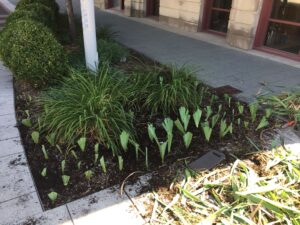Ethan, Cultural Trail Horticulture Manager
This week’s Lunch and Learn covered the basics of Garden Prep. Once the snow melts and the grass peaks out, it’s time to start planning for your garden. However, be careful because freezing temperatures are common throughout April and frost will kill certain plants. However, that doesn’t mean that you need to stay in the house!
Here are four areas to focus now to set up your garden for success later:
- Clean up
- Cut back plant debris.
- Cut and dispose of dead, diseased or damaged “woody” material.

- Remove leaves that have piled high and matted together, some leaves are fine.
- Leave a pile of small twigs, brush, leaves and grasses. This “wildlife hotel” will slowly disappear as critters take from it to make nests and dens.
- Prep the soil
- Get a soil sample. This is the recommended lab in Indiana. They will tell you what you should be adding to your soil, including compost and give suggestions about pH adjustments. Be mindful – each yard is very different and adding materials could be a waste of time/money and create a surplus of material which is damaging to the plants and environment.
- Do not “lasagna mulch” or cover areas with cardboard. It interferes with gas exchange to the soil.
- Do not add potting soil from bags, peat moss, vermiculite, or epsom salt to your soil.
- Do not till soil. As it turns out, this destroys the soil structure which creates several problems and actually plants thousands of weed seeds at the same time. Dig the into the areas you need and leave the rest untouched.
- Start limiting your number of weeds
- Do not disturb the soil line by tilling, shoveling or raking. You are just activating a seed bank and planting weeds that you will be fighting May-September.
- Cover the soil with things you want:
- Plants- trees, shrubs or ground covers shade out the weeds and keep them from germinating/growing
- Mulch/arborist chips- hardwood mulch helps keep the sun from germinating seeds on the soil by smothering.
- Pre-emergent- this creates a chemical layer on the soil that does not let seeds germinate and leaves established plants unharmed.
- Mulch
You can start mulching now, but I suggest waiting just a touch longer. By waiting, you do not make it as difficult for your perennials to emerge. You want to stop the weeds, not your desirable plants and too much mulch will choke your plants. Avoid creating seas of mulch with tiny islands of plants scattered throughout. Mulch should help your plants – it shouldn’t take center stage.

Gardening is mastered through trial and error. Take notes on what you do differently from season to season and notice the change. Gardening in spring is the easiest, so right now you should be setting yourself up for success through peak summer. Remember that what you do right now might not show any effect until mid to late summer.
When evaluating what you did in your garden each year, ask yourself: Did cutting the plant back give it more blooms? Did leaving the leaves against the fence create a headache? Did one raised bed have lots more weeds? Gardening and landscaping is endlessly nuanced and each year will be very different. Lean into that, know that variances are normal and enjoy the “fruits” of your labor.
Interested in learning more from the ICT staff? Join us Wednesdays at noon on Instagram Live as we continue our Lunch and Learn series. Next up – stormwater planters! Want to get your hands dirty along the Trail? Help us take care of the trail’s landscape at Landscaping and Lagers on Wednesdays from 5-7 p.m., or drop-in to volunteer Tuesdays through Thursdays from 9 a.m. – 3 p.m. and we’ll supply you with the tools you need to spruce up the Trail.